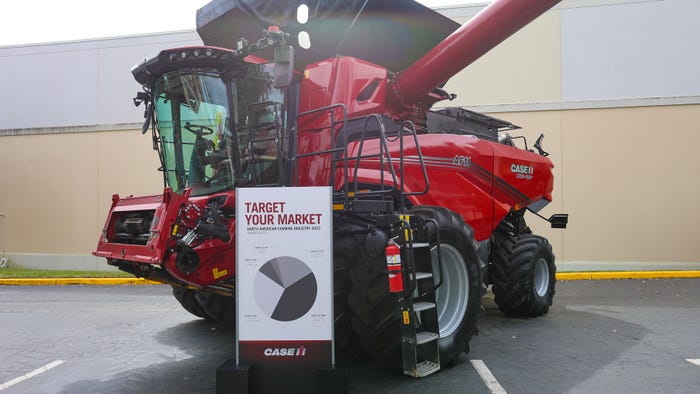February 7, 2024

More grain capacity and a faster dump speed are the two most notable features of Case IH’s freshly minted AF11 combine harvester. The Wisconsin-based manufacturer unveiled its next-generation combine at a media event Feb. 5 near Orlando, Fla.
“This is a redesign from the ground up,” says Leo Bose, harvesting marketing manager for Case IH North America. “When you look at the wheelbase, we’ve actually lengthened it out. We’re supporting a massive grain tank up top — 567 bushels. It all starts in the feeder house area. The feeder house is not only wider; it allows a thicker crop mat.”
The machine’s size was obvious as it covered a large swath of parking spaces outside Omni Orlando Resort, with its 50-foot draper head extending upward. Available for order through dealers this summer, the AF11 will be on display at the National Farm Machinery Show on Feb. 14-17. Pricing is not yet available.
Integrating efficiency
Efficiency and automation are embedded throughout the combine. Bose says radar sensors can “automatically adjust residue spread based on the header width.” And automatic row guidance lets the operator “snap a line and stay on the row as, say, you go through a waterway.”
With its automated cleaning system, a large fan moves a higher volume of air at a slower speed. Four sieves — one more than past models — and an active grain pan shake and move the crop from side to side, keeping it level. Two cross augers bring the crop to a clean grain elevator, which has a 10,000-bushel-per-hour capacity, increasing the system’s efficiency by about 30 percent, according to Bose.
“If you get into some sidehill situations, or again, just crop mat situations, you’ll be able to use 100% of that across your harvesting operation,” says Ryan Kau, who is also a harvesting marketing manager for Case IH North America. “A larger cleaning fan doesn’t need to spin as fast, meaning you have some horsepower gains throughout the machine, giving us additional horsepower where we need it.”
When unloading, the belt-driven augers can dump at a maximum speed of 6 bushels per second — and notably don’t need to be tensioned or oiled like their chain-driven counterparts.
“If you do the math, that’s less than 6 seconds that the grain tank will be unloaded,” Kau says.
And if the operator wants to slow the dump rate down, they can shut off one of the cross augers and reduce the flow from 6 bushels to 3.
Inside the cab, dual display monitors are equipped with AFS Harvest Command and let the operator watch the grain in real time, adjusting if it’s cracked, Kau says.
And the heated leather seats have a massage feature. “For those 12-, 14-hour days,” Bose says.
Under the hood, the combine’s threshing segment draws power from Case IH’s first-ever dual rotor, the AFXL2. The rotors are physically longer, Bose says, and can automatically reverse.
“The varieties they have today, green stem beans, typically hold the kernel within. Now, we have more separation that can take place, all driven by the Power Plus power system.”
Smoother power transfer
Engineers achieved efficiency upgrades by physically shifting the combine’s engine and cutting down on bends and turns in power transfer, according to Nathan Graham, a product training specialist with Case IH’s parent company, CNH Industrial. Standing on a catwalk atop the combine, he gestures to the machine’s visibly accessible 775-hp engine.
“One of the first things you’ll see up here on the AF11 is the engine has been moved 90 degrees, so now it is actually in line with the vehicle. Prior to, we sat off to the side,” Graham says. “Our PTO gearbox, which runs all the major functions of the combine, is right in this area. That used to be mounted to the side.”
With more space, engineers moved the combine’s drives to either side, giving them the ability to move forward with less parasitic power losses, according to Graham. “We save a lot of power in that way, and we can move that power to crop threshing, and crop separating and crop cleaning,” he says.
Future-proof equipment
Looking to the future, Marisa Riley, director of marketing for Case IH North America, says the combine was designed with digital "openness" to support future innovation. The physical structure is the same. Anticipating that headers will one day be built wider, the lifter’s capacity goes up to 15,000 pounds.
“We’re future-proofing,” says Kurt Coffey, vice president of Case IH North America. “You have to automate all of those little building blocks before you’re fully automated. We’re biting off those building blocks one at a time along the way.”
The AF11’s launch follows an announcement at the 2024 NCBA Cattle Con of Case IH's new Baler Automation technology, which leverages LiDAR (light detection and ranging) to measure the position and size of windrows.
With this data, the system automatically adjusts the tractor's steering and speed to maximize throughput without overloading the baler, according to a press statement. The dealer-installed automation kit connects with Class 3 ISOBUS Puma, Optum and Magnum tractors. For more information, visit caseih.com.
About the Author(s)
You May Also Like






